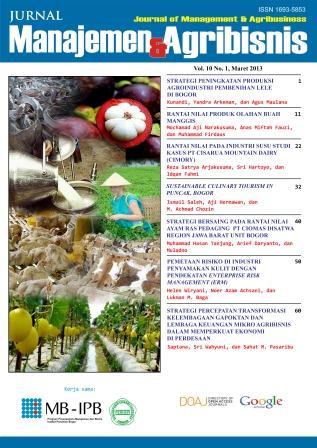Abstract
ABSTRACT
This research analyzed the sustainability of culinary tourism in Puncak, comprising the strategic issues review, and comparing its sustainability aspects to the existing culinary enterprises. This study employed a qualitative-descriptive analysis method in three cases: a large-scale Cimory Restaurant, a medium-scale restaurant/café Melrimba Garden, and small-scaled street hawkers in At-Ta'awun rest area. In general, the value chain was categorized into five major band based on their function: Food Service Business; Suppliers (local community, traders, cooperatives); End user (tourists and customers); Governance (government, areal coordinator, Kompepar); and Intermediaries (distributors, tour agents). There were at least five strategic issues that emerged in the tourism development in Puncak area: 1) land function conversion. 2) Economic and social impact of tourism to the local community; 3) Participation of locals in tourism activity; 4) Traffic and infrastructure, and 5) Waste management. The three restaurant operators were compared in term of sustainability criteria, based on their customers’ preferences, and three aspects of sustainability: economic, environment, and social. It was found that Cimory scored the best in sustainability performance and followed by Melrimba. The street hawkers, with several note, scored as third in the sustainability performance.
Keywords: culinary tourism, ecotourism, puncak, value chain, sustainable tourism
ABSTRAK
Penelitian bertujuan menganalisis keberlanjutan pariwisata kuliner di Puncak, meliputi kajian isu-isu strategis dalam pariwisata kuliner, dan perbandingan aspek keberlanjutan dari usaha kuliner yang sudah ada. Penelitian ini menggunakan metode analisis deskriptif-kualitatif pada tiga kasus: restoran skala besar Cimory, rumah makan/kafe skala menengah Melrimba Garden, dan penjaja/pedagang asongan di area istirahat At-Ta’awun sebagai pengusaha kuliner skala kecil. Secara umum, rantai nilai dikategorikan menjadi lima kelompok utama berdasarkan fungsinya: penyedia layanan makanan; pemasok (masyarakat lokal, pedagang, dan koperasi); konsumen akhir (turis dan pelanggan); pemerintahan (pemerintah Kabupaten Bogor, areal koordinator, kompepar), dan perantara (distributor, agen tur). Setidaknya ada lima isu strategis yang terjadi dalam pengembangan pariwisata di daerah Puncak: 1) konversi fungsi lahan; 2) dampak ekonomi dan sosial, 3) partisipasi masyarakat lokal dalam kegiatan pariwisata; 4) lalu lintas dan infrastruktur di daerah Puncak, dan 5) pengelolaan sampah. Ketiga restoran memiliki kriteria keberlanjutan, hasil preferensi pelanggan, dan tiga aspek keberlanjutan (ekonomi, lingkungan, dan sosial). Cimory memiliki nilai yang terbaik dalam kinerja keberlanjutan dan diikuti oleh Melrimba. Pedagang kaki lima, dengan beberapa catatan, mencetak nilai sebagai peringkat terakhir dalam kinerja keberlanjutan.
Kata kunci: wisata kuliner, ekowisata, puncak, rantai nilai, wisata berkelanjutan
This research analyzed the sustainability of culinary tourism in Puncak, comprising the strategic issues review, and comparing its sustainability aspects to the existing culinary enterprises. This study employed a qualitative-descriptive analysis method in three cases: a large-scale Cimory Restaurant, a medium-scale restaurant/café Melrimba Garden, and small-scaled street hawkers in At-Ta'awun rest area. In general, the value chain was categorized into five major band based on their function: Food Service Business; Suppliers (local community, traders, cooperatives); End user (tourists and customers); Governance (government, areal coordinator, Kompepar); and Intermediaries (distributors, tour agents). There were at least five strategic issues that emerged in the tourism development in Puncak area: 1) land function conversion. 2) Economic and social impact of tourism to the local community; 3) Participation of locals in tourism activity; 4) Traffic and infrastructure, and 5) Waste management. The three restaurant operators were compared in term of sustainability criteria, based on their customers’ preferences, and three aspects of sustainability: economic, environment, and social. It was found that Cimory scored the best in sustainability performance and followed by Melrimba. The street hawkers, with several note, scored as third in the sustainability performance.
Keywords: culinary tourism, ecotourism, puncak, value chain, sustainable tourism
ABSTRAK
Penelitian bertujuan menganalisis keberlanjutan pariwisata kuliner di Puncak, meliputi kajian isu-isu strategis dalam pariwisata kuliner, dan perbandingan aspek keberlanjutan dari usaha kuliner yang sudah ada. Penelitian ini menggunakan metode analisis deskriptif-kualitatif pada tiga kasus: restoran skala besar Cimory, rumah makan/kafe skala menengah Melrimba Garden, dan penjaja/pedagang asongan di area istirahat At-Ta’awun sebagai pengusaha kuliner skala kecil. Secara umum, rantai nilai dikategorikan menjadi lima kelompok utama berdasarkan fungsinya: penyedia layanan makanan; pemasok (masyarakat lokal, pedagang, dan koperasi); konsumen akhir (turis dan pelanggan); pemerintahan (pemerintah Kabupaten Bogor, areal koordinator, kompepar), dan perantara (distributor, agen tur). Setidaknya ada lima isu strategis yang terjadi dalam pengembangan pariwisata di daerah Puncak: 1) konversi fungsi lahan; 2) dampak ekonomi dan sosial, 3) partisipasi masyarakat lokal dalam kegiatan pariwisata; 4) lalu lintas dan infrastruktur di daerah Puncak, dan 5) pengelolaan sampah. Ketiga restoran memiliki kriteria keberlanjutan, hasil preferensi pelanggan, dan tiga aspek keberlanjutan (ekonomi, lingkungan, dan sosial). Cimory memiliki nilai yang terbaik dalam kinerja keberlanjutan dan diikuti oleh Melrimba. Pedagang kaki lima, dengan beberapa catatan, mencetak nilai sebagai peringkat terakhir dalam kinerja keberlanjutan.
Kata kunci: wisata kuliner, ekowisata, puncak, rantai nilai, wisata berkelanjutan
Authors
SalehI., HermawanA., & ChozinM. A. (2014). SUSTAINABLE CULINARY TOURISM IN PUNCAK, BOGOR. Jurnal Manajemen & Agribisnis, 10(1), 32-39. https://doi.org/10.17358/jma.10.1.32-39
Authors who publish with this journal agree to the following terms:
- Authors retain copyright and grant the journal right of first publication with the work simultaneously licensed under a Creative Commons Attribution License that allows others to share the work with an acknowledgement of the work's authorship and initial publication in this journal.
- Authors are able to enter into separate, additional contractual arrangements for the non-exclusive distribution of the journal's published version of the work (e.g., post it to an institutional repository or publish it in a book), with an acknowledgement of its initial publication in this journal.
- Authors are permitted and encouraged to post their work online (e.g., in institutional repositories or on their website) prior to and during the submission process, as it can lead to productive exchanges, as well as earlier and greater citation of published work (See The Effect of Open Access).

